This site uses cookies as defined in our Cookie Policy, by continuing to use this site you agree to their use.
Continue
| Arrive | Depart | ||||||
| 5th05 | AugAug | 202626 | Southampton, England, embark on the Arcadia | ||||
Lying near the head of Southampton Water, a peninsula between the estuaries of the Rivers Test and Itchen, Southampton is Britain’s largest cruise port. It has been one of England’s major ports since the Middle Ages, when it exported wool and hides from the hinterland and imported wine from Bordeaux. The city suffered heavy damage during World War Two and as a result the centre has been extensively rebuilt, but there are still some interesting medieval buildings including the Bargate, one of the finest city gatehouses in England. | |||||||
| 6th06 | AugAug | 202626 | At Sea | ||||
| 7th07 | AugAug | 202626 | At Sea | ||||
| 8th08 | AugAug | 202626 | At Sea | ||||
| 9th09 | AugAug | 202626 | Reykjavík, Iceland | Early Morning | |||
Sprawling Reykjavík, the nation's nerve center and government seat, is home to half the island's population. On a bay overlooked by proud Mt. Esja (pronounced eh-shyuh), with its ever-changing hues, Reykjavík presents a colorful sight, its concrete houses painted in light colors and topped by vibrant red, blue, and green roofs. In contrast to the almost treeless countryside, Reykjavík has many tall, native birches, rowans, and willows, as well as imported aspen, pines, and spruces.Reykjavík's name comes from the Icelandic words for smoke, reykur, and bay, vík. In AD 874, Norseman Ingólfur Arnarson saw Iceland rising out of the misty sea and came ashore at a bay eerily shrouded with plumes of steam from nearby hot springs. Today most of the houses in Reykjavík are heated by near-boiling water from the hot springs. Natural heating avoids air pollution; there's no smoke around. You may notice, however, that the hot water brings a slight sulfur smell to the bathroom.Prices are easily on a par with other major European cities. A practical option is to purchase a Reykjavík City Card at the Tourist Information Center or at the Reykjavík Youth Hostel. This card permits unlimited bus usage and admission to any of the city's seven pools, the Family Park and Zoo, and city museums. The cards are valid for one (ISK 3,300), two (ISK 4,400), or three days (ISK 4,900), and they pay for themselves after three or four uses a day. Even lacking the City Card, paying admission (ISK 500, or ISK 250 for seniors and people with disabilities) to one of the city art museums (Hafnarhús, Kjarvalsstaðir, or Ásmundarsafn) gets you free same-day admission to the other two. | |||||||
| 10th10 | AugAug | 202626 | Reykjavík, Iceland | Afternoon | |||
Sprawling Reykjavík, the nation's nerve center and government seat, is home to half the island's population. On a bay overlooked by proud Mt. Esja (pronounced eh-shyuh), with its ever-changing hues, Reykjavík presents a colorful sight, its concrete houses painted in light colors and topped by vibrant red, blue, and green roofs. In contrast to the almost treeless countryside, Reykjavík has many tall, native birches, rowans, and willows, as well as imported aspen, pines, and spruces.Reykjavík's name comes from the Icelandic words for smoke, reykur, and bay, vík. In AD 874, Norseman Ingólfur Arnarson saw Iceland rising out of the misty sea and came ashore at a bay eerily shrouded with plumes of steam from nearby hot springs. Today most of the houses in Reykjavík are heated by near-boiling water from the hot springs. Natural heating avoids air pollution; there's no smoke around. You may notice, however, that the hot water brings a slight sulfur smell to the bathroom.Prices are easily on a par with other major European cities. A practical option is to purchase a Reykjavík City Card at the Tourist Information Center or at the Reykjavík Youth Hostel. This card permits unlimited bus usage and admission to any of the city's seven pools, the Family Park and Zoo, and city museums. The cards are valid for one (ISK 3,300), two (ISK 4,400), or three days (ISK 4,900), and they pay for themselves after three or four uses a day. Even lacking the City Card, paying admission (ISK 500, or ISK 250 for seniors and people with disabilities) to one of the city art museums (Hafnarhús, Kjarvalsstaðir, or Ásmundarsafn) gets you free same-day admission to the other two. | |||||||
| 11th11 | AugAug | 202626 | Grundarfjørdur, Iceland | Early Morning | Early Evening | ||
| 12th12 | AugAug | 202626 | Isafjørdur, Iceland | Early Morning | Early Evening | ||
Two colossal terraces of sheer rock stand either side of this extraordinarily located town - which rides a jutting spit onto an immensity of black fjord water. Surprisingly, considering the remoteness of its location and its compact size, Isafjordur is a modern and lively place to visit, offering a great choice of cafes and delicious restaurants – which are well stocked to impress visitors. The town is a perfectly located base for adventures amongst Iceland's fantastic wilderness - with skiing, hiking and water-sports popular pursuits among visitors. | |||||||
| 13th13 | AugAug | 202626 | Akureyri, Iceland | Early Morning | Afternoon | ||
Akureyri, called the Capital of the North is the second largest urban area in Iceland, and a lively one at that. Hemmed by the 60-km (37-mile) long Eyjafjörður, Akureyri is sheltered from the ocean winds and embraced by mountains on three sides. Late 19th-century wooden houses impart a sense of history, and the twin spires of a modern Lutheran church rising on a green hill near the waterfront, provide a focal point. To the south of Akureyri is the pyramid-shape rhyolite mountain Súlur. Beyond it is Kerling, the highest peak in Eyjafjörður District. | |||||||
| 14th14 | AugAug | 202626 | At Sea | ||||
| 15th15 | AugAug | 202626 | Stornoway, Isle of Lewis, Scotland | Morning | Early Evening | ||
Tour description Stornoway, Scotland The Isle of Lewis and Harris is the northernmost and largest of the Outer Hebrides-the Western Isles in common parlance. The island's only major town, Stornoway, is on a nearly landlocked harbor on the east coast of Lewis. It's the port capital for the Outer Hebrides and the island's cultural center, such that it is. Stornoway has an increasing number of good restaurants. Lewis has some fine historic attractions, including the Calanais Standing Stones-a truly magical place. The Uists are known for their rare, plentiful wildlife. Stornoway. Besides being the island's main entry point for ferries, Stornoway is also Lewis's main arts center. You'll find some good restaurants in town if you want to have lunch off the ship. The town can be explored by bicycle if you are so inclined. Local rental shops can give you advice on where to ride, including a route to Tolsta that takes in five stunning beaches before reaching the edge of moorland. An Lanntair Arts Centre. The fabulous An Lanntair Arts Centre has exhibitions of contemporary and traditional art, as well as a cinema, a gift shop, and a restaurant serving international and Scottish fare. There are frequent traditional musical and theatrical events in the impressive auditorium. Kenneth St.. Black House. In the small community of Arnol, the Black House is a well-preserved example of an increasingly rare type of traditional Hebridean home. Once common throughout the islands-even into the 1950s-these dwellings were built without mortar and thatched on a timber framework without eaves. Other characteristic features include an open central peat hearth and the absence of a chimney-hence the soot and the designation black. On display inside are many of the house's original furnishings. To reach Arnol from Port of Ness, head south on the A857 and pick up the A858 at Barvas. Off A858, 21 mi southwest of Port of Ness. Admission charged. Calanais Standing Stones. These impressive stones are actually part of a cluster of several different archaeological sites in this area. Probably positioned in several stages between 3000 BC and 1500 BC, the grouping consists of an avenue of 19 monoliths extending northward from a circle of 13 stones, with other rows leading south, east, and west. Ruins of a cairn sit within the circle on the east side. Researchers believe they may have been used for astronomical observations, but you can create your own explanations. The visitor center has an exhibit on the stones, a gift shop, and a tearoom. On an unmarked road off A858. Admission charged. Dun Carloway. One of the best-preserved Iron Age brochs (circular stone towers) in Scotland, Dun Carloway dominates the scattered community of Carloway. The mysterious tower was probably built around 2,000 years ago as protection against seaborne raiders. The Dun Broch Centre explains more about the broch and its setting. Off A857. Gearrannan. Up a side road north from Carloway, Gearrannan is an old black-house village that has been brought back to life with a museum screening excellent short films on peat cutting and weaving. For a unique experience, groups can rent the restored houses. Leverburgh. At Leverburgh you can take the ferry to North Uist. Nearby Northton has several attractions; St. Clement's Church at Rodel is particularly worth a visit. MacGillivray Centre. Located in a round building overlooking the bay, the MacGillivray Centre gives insight into the life and work of William MacGillivray (1796-1852), a noted naturalist with strong links to Harris. MacGillivray authored the five-volume History of British Birds. This is a great location for a picnic (there are tables for just such a purpose). A walk to a ruined church starts at the parking lot. A859, Northton. Seallam! Visitor Centre and Co Leis Thu? Genealogical Research Centre. The center is where you can trace your Western Isles ancestry. Photographs and interpretive signs describe the history of Harris and its people. The owners organize guided walks and cultural evenings weekly between May and September. Off A859, Northton. Admission charged. St. Clement's Church. At the southernmost point of Harris is the community of Rodel, where you can find St. Clement's Church, a cruciform church standing on a hillock. This is the most impressive pre-Reformation church in the Outer Hebrides; it was built around 1500 and contains the magnificently sculptured tomb (1528) of the church's builder, Alasdair Crotach, MacLeod chief of Dunvegan Castle. Rodel is 3 mi south of Leverburgh and 21 mi south of Tarbert. A859, Rodel. Port of Ness. The stark, windswept community of Port of Ness, 30 mi north of Stornoway, cradles a small harbor squeezed in among the rocks. Butt of Lewis Lighthouse. At the northernmost point of Lewis stands the Butt of Lewis Lighthouse, designed by David and Thomas Stevenson (of the prominent engineering family whose best-known member was not an engineer at all, but the novelist Robert Louis Stevenson). The structure was first lighted in 1862. The adjacent cliffs provide a good vantage point for viewing seabirds, whales, and porpoises. The lighthouse is northwest of Port of Ness along the B8014. Shopping Harris tweed is available at many outlets on the islands, including some of the weavers' homes; keep an eye out for signs directing you to weavers' workshops. Harris Tweed Artisans Cooperative. The Harris Tweed Artisans Cooperative sells stylish and quirky hand-crafted tweed clothing, hats, accessories, all made by artists belonging to the cooperative. 40 Point St., Stornoway. Borgh Pottery. At Borgh Pottery, open from Monday to Saturday 9:30 to 6, you can buy attractive hand-thrown studio pottery made on the premises, including lamps, vases, mugs, and dishes. Fivepenny House, A857, Borve. | |||||||
| 16th16 | AugAug | 202626 | At Sea | ||||
| 17th17 | AugAug | 202626 | Greenock, Scotland | Morning | |||
Trendy stores, a booming cultural life, fascinating architecture, and stylish restaurants reinforce Glasgow's claim to being Scotland's most exciting city. After decades of decline, it has experienced an urban renaissance uniquely its own. The city’s grand architecture reflects a prosperous past built on trade and shipbuilding. Today buildings by Charles Rennie Mackintosh hold pride of place along with the Zaha Hadid–designed Riverside Museum.Glasgow (the "dear green place," as it was known) was founded some 1,500 years ago. Legend has it that the king of Strathclyde, irate about his wife's infidelity, had a ring he had given her thrown into the river Clyde. (Apparently she had passed it on to an admirer.) When the king demanded to know where the ring had gone, the distraught queen asked the advice of her confessor, St. Mungo. He suggested fishing for it—and the first salmon to emerge had the ring in its mouth. The moment is commemorated on the city's coat of arms.The medieval city expanded when it was given a royal license to trade; the current High Street was the main thoroughfare at the time. The vast profits from American cotton and tobacco built the grand mansions of the Merchant City in the 18th century. In the 19th century the river Clyde became the center of a vibrant shipbuilding industry, fed by the city’s iron and steel works. The city grew again, but its internal divisions grew at the same time. The West End harbored the elegant homes of the newly rich shipyard owners. Down by the river, areas like the infamous Gorbals, with its crowded slums, sheltered the laborers who built the ships. They came from the Highlands, expelled to make way for sheep, or from Ireland, where the potato famines drove thousands from their homes.During the 19th century the population grew from 80,000 to more than a million. And the new prosperity gave Glasgow its grand neoclassical buildings, such as those built by Alexander "Greek" Thomson, as well as the adventurous visionary buildings designed by Charles Rennie Mackintosh and others who produced Glasgow’s Arts and Crafts movement. The City Chambers, built in 1888, are a proud statement in marble and gold sandstone, a clear symbol of the wealthy and powerful Victorian industrialists' hopes for the future.The decline of shipbuilding and the closure of the factories led to much speculation as to what direction the city would take now. The curious thing is that, at least in part, the past gave the city a new lease of life. It was as if people looked at their city and saw Glasgow’s beauty for the first time: its extraordinarily rich architectural heritage, its leafy parks, its artistic heritage, and its complex social history. Today Glasgow is a vibrant cultural center and a commercial hub, as well as a launching pad from which to explore the rest of Scotland, which, as it turns out, is not so far away. In fact, it takes only 40 minutes to reach Loch Lomond, where the other Scotland begins. | |||||||
| 18th18 | AugAug | 202626 | Greenock, Scotland | Before 0900 | |||
Trendy stores, a booming cultural life, fascinating architecture, and stylish restaurants reinforce Glasgow's claim to being Scotland's most exciting city. After decades of decline, it has experienced an urban renaissance uniquely its own. The city’s grand architecture reflects a prosperous past built on trade and shipbuilding. Today buildings by Charles Rennie Mackintosh hold pride of place along with the Zaha Hadid–designed Riverside Museum.Glasgow (the "dear green place," as it was known) was founded some 1,500 years ago. Legend has it that the king of Strathclyde, irate about his wife's infidelity, had a ring he had given her thrown into the river Clyde. (Apparently she had passed it on to an admirer.) When the king demanded to know where the ring had gone, the distraught queen asked the advice of her confessor, St. Mungo. He suggested fishing for it—and the first salmon to emerge had the ring in its mouth. The moment is commemorated on the city's coat of arms.The medieval city expanded when it was given a royal license to trade; the current High Street was the main thoroughfare at the time. The vast profits from American cotton and tobacco built the grand mansions of the Merchant City in the 18th century. In the 19th century the river Clyde became the center of a vibrant shipbuilding industry, fed by the city’s iron and steel works. The city grew again, but its internal divisions grew at the same time. The West End harbored the elegant homes of the newly rich shipyard owners. Down by the river, areas like the infamous Gorbals, with its crowded slums, sheltered the laborers who built the ships. They came from the Highlands, expelled to make way for sheep, or from Ireland, where the potato famines drove thousands from their homes.During the 19th century the population grew from 80,000 to more than a million. And the new prosperity gave Glasgow its grand neoclassical buildings, such as those built by Alexander "Greek" Thomson, as well as the adventurous visionary buildings designed by Charles Rennie Mackintosh and others who produced Glasgow’s Arts and Crafts movement. The City Chambers, built in 1888, are a proud statement in marble and gold sandstone, a clear symbol of the wealthy and powerful Victorian industrialists' hopes for the future.The decline of shipbuilding and the closure of the factories led to much speculation as to what direction the city would take now. The curious thing is that, at least in part, the past gave the city a new lease of life. It was as if people looked at their city and saw Glasgow’s beauty for the first time: its extraordinarily rich architectural heritage, its leafy parks, its artistic heritage, and its complex social history. Today Glasgow is a vibrant cultural center and a commercial hub, as well as a launching pad from which to explore the rest of Scotland, which, as it turns out, is not so far away. In fact, it takes only 40 minutes to reach Loch Lomond, where the other Scotland begins. | |||||||
| 19th19 | AugAug | 202626 | Cobh, Ireland | Early Morning | Afternoon | ||
Cork City's nearby harbor district has seen plenty of history. Cork Harbour's draws include Fota Island—with an arboretum, a wildlife park, and the Fota House ancestral estate—and the fishing port of Cobh. | |||||||
| 20th20 | AugAug | 202626 | At Sea | ||||
| 21st21 | AugAug | 202626 | Southampton, England, disembark the Arcadia | ||||
Lying near the head of Southampton Water, a peninsula between the estuaries of the Rivers Test and Itchen, Southampton is Britain’s largest cruise port. It has been one of England’s major ports since the Middle Ages, when it exported wool and hides from the hinterland and imported wine from Bordeaux. The city suffered heavy damage during World War Two and as a result the centre has been extensively rebuilt, but there are still some interesting medieval buildings including the Bargate, one of the finest city gatehouses in England. | |||||||
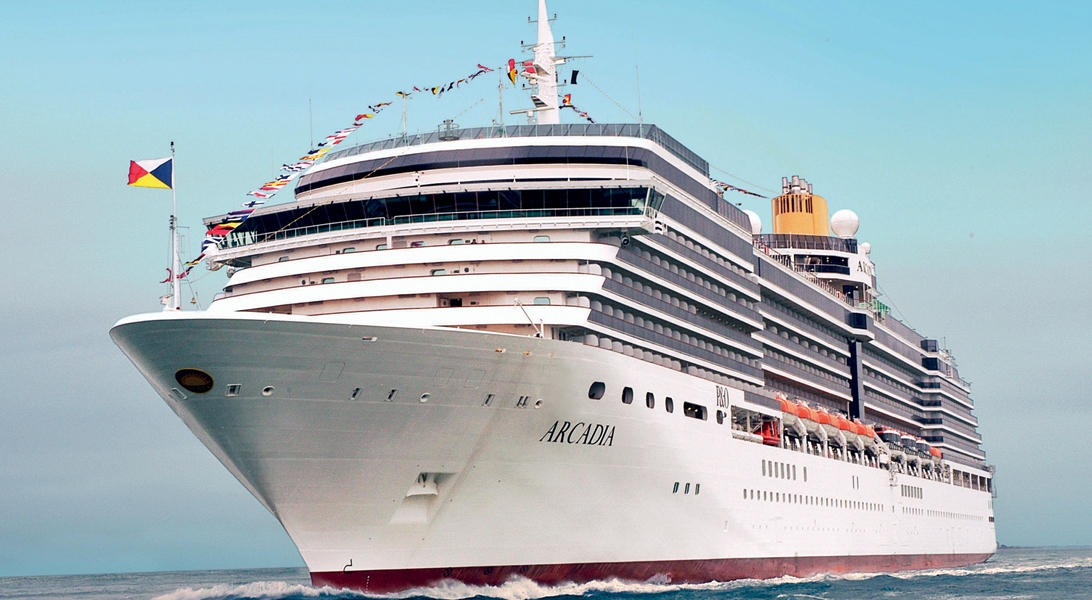











The images shown are for illustration purposes only and may not be an exact representation of what you find on the ship.
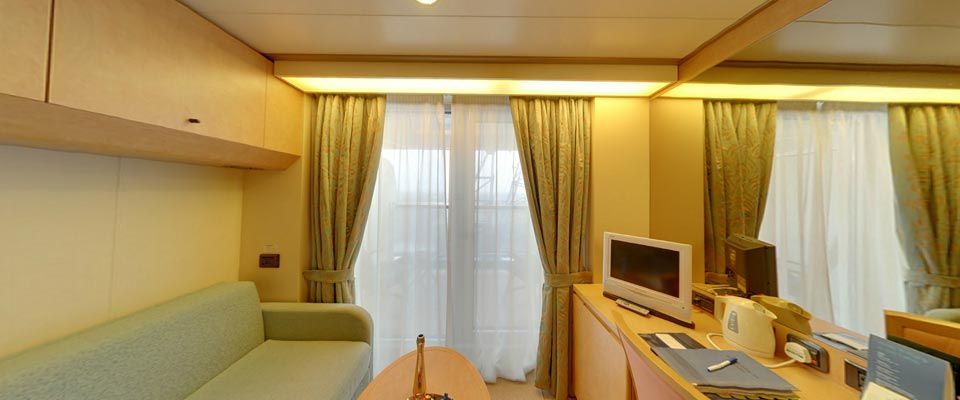
| Grade Code | From | To | |
| EF | Deluxe Balcony | £3,299 | £3,699 |
| EE | Deluxe Balcony | £3,399 | £3,749 |
| ED | Deluxe Balcony | £3,449 | £3,799 |
| EC | Deluxe Balcony | £3,499 | £3,829 |
| EB | Deluxe Balcony | £3,549 | £3,949 |
| EA | Deluxe Balcony | £3,629 | £4,049 |
There's nothing quite like opening your patio style doors onto your own private balcony, especially to take in the fresh morning air or to enjoy a spectacular sail in to your next destination.
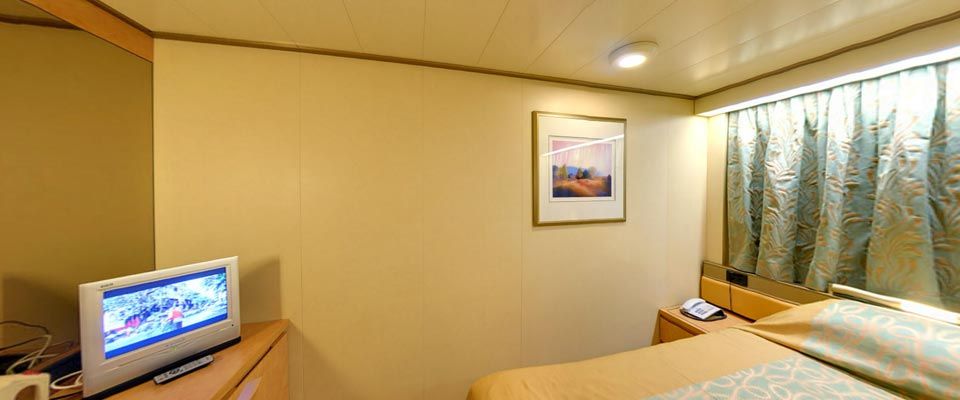
| Grade Code | From | To | |
| PF | Inside | £2,799 | £2,999 |
| PE | Inside | £2,819 | £3,069 |
| PD | Inside | £2,869 | £3,099 |
| PB | Inside | £2,899 | £3,119 |
| PA | Inside | £2,899 | £3,139 |
| OC | Larger Inside | £2,969 | £3,209 |
| OA | Larger Inside | £2,999 | £3,319 |
| OB | Larger Inside | £2,999 | £3,239 |
These spacious cabins are perfect if you want a more economical way to travel and prefer to be out and about experiencing the ship or reclining up on deck by the pools.
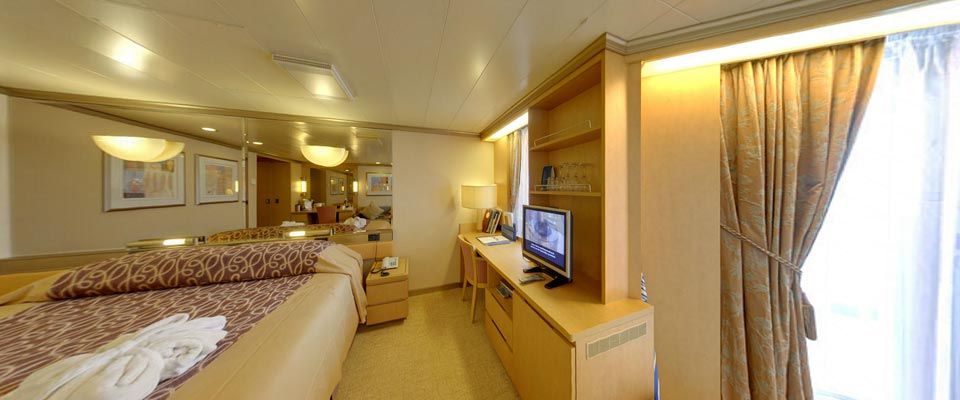
| Grade Code | From | To | |
| CE | Mini-Suite | £5,299 | £5,649 |
| CB | Mini-Suite | £5,559 | £5,979 |
| CA | Mini-Suite | £5,769 | £6,199 |
These fully air-conditioned suites feature two single beds, convertible to one king-size bed. The bathrooms boast a whirlpool bath, shower, dual sink vanity unit and a WC. Suites include a complimentary premier pamper pack with bathrobe & slippers. Additionally there is an iron & ironing board, trouser press and a hairdryer.
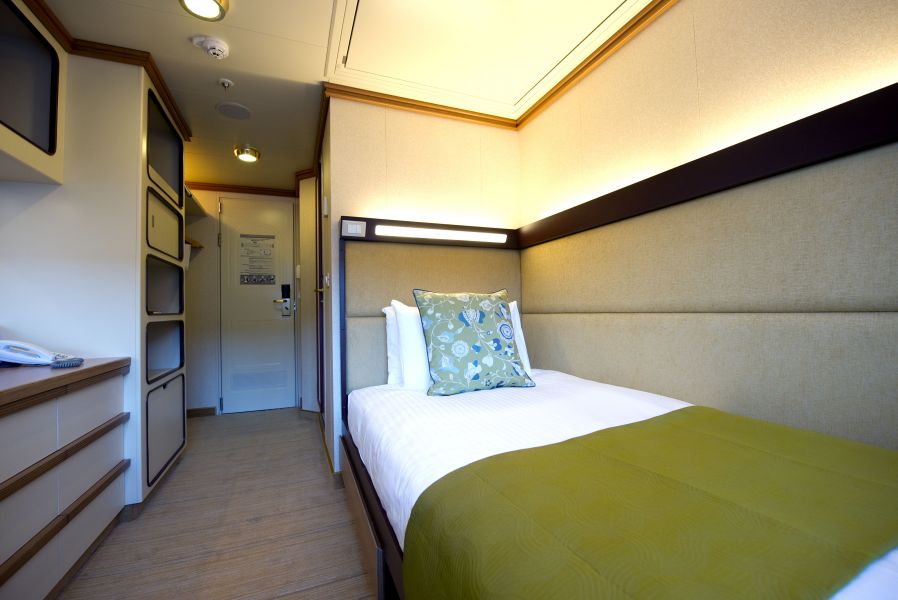
| Grade Code | From | To | |
| SC | Single Inside | £3,779 | £4,159 |
| QF | Single Balcony | £6,459 | £7,129 |
These spacious cabins are perfect if you want a more economical way to travel and prefer to be out and about experiencing the ship or reclining up on deck by the pools.
The images shown are for illustration purposes only and may not be an exact representation of what you find on the ship.
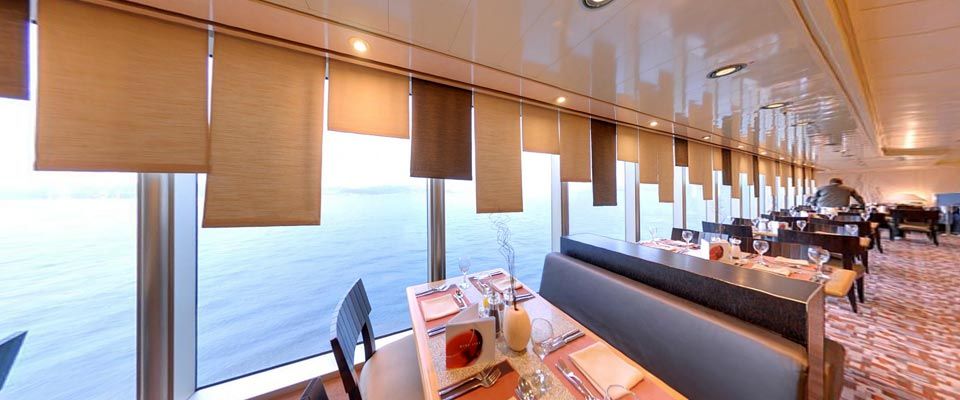
No matter what time of day it is, if you fancy a good meal you'll always get one on board Arcadia. The Belvedere food court offers informal dining around the clock. With a wide choice of menus from Oriental and Italian to bistro-style dishes and a delicatessen counter, this stylish and modern venue is the place to go for casual dining any time of the day or night. So if you've just returned to the ship after a shore excursion and have worked up a late afternoon appetite you can still enjoy a great meal.
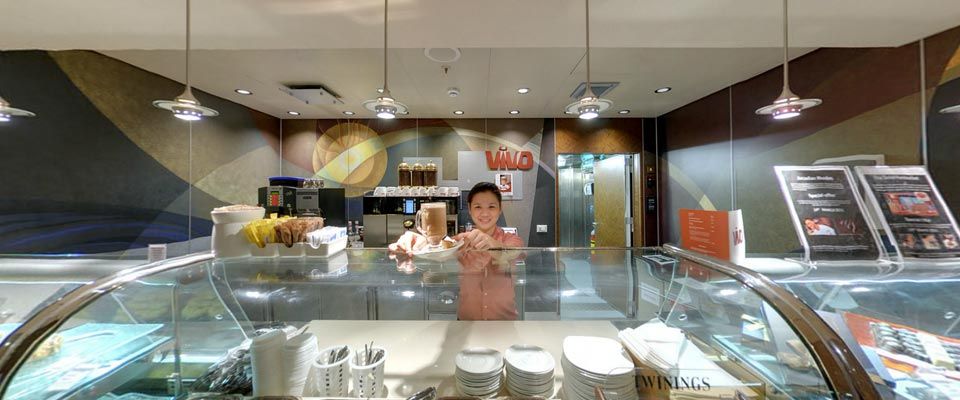
Just a few steps away from Arcadia's shops, this fantastic coffee shop is a great place to take a break and people watch.
Located on the starboard side of Promenade Deck, between the Library and The Screening Room, is Caffè Vivo. Adorned with brown leather sofas, high tables and stools and wooden floors, Caffè Vivo takes its cues from the warmth and vibrancy of the Mediterranean and provides a cosy and inviting atmosphere. Relax over a delectable cookie or pastry with a magazine, refresh your palate with a smoothie or freshly squeezed juice, or opt for a lunchtime snack. With anything from salads and bagels, to crostini and noodles on the menu, Caffè Vivo is much more than simply a coffee bar.
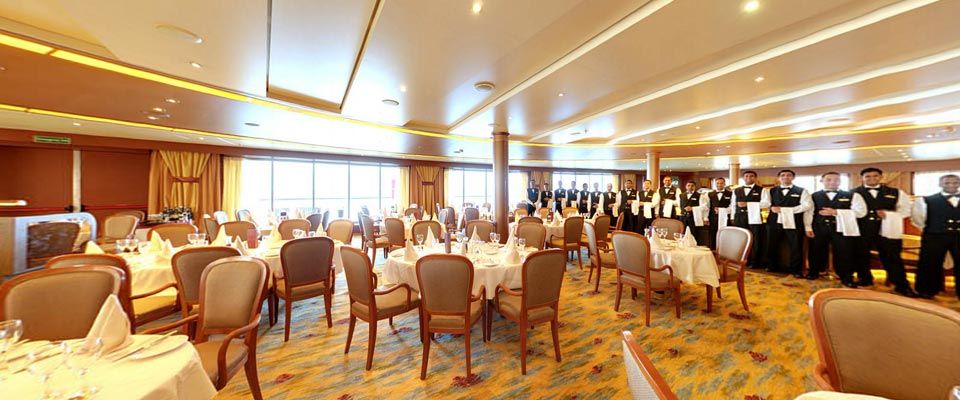
Featuring a two-tiered layout and refined décor, every night will be an occasion in the Meridian Restaurant. Enjoy the special ambience and sociable atmosphere of a main dining room, with a five-course menu (six-course on Gala Nights).
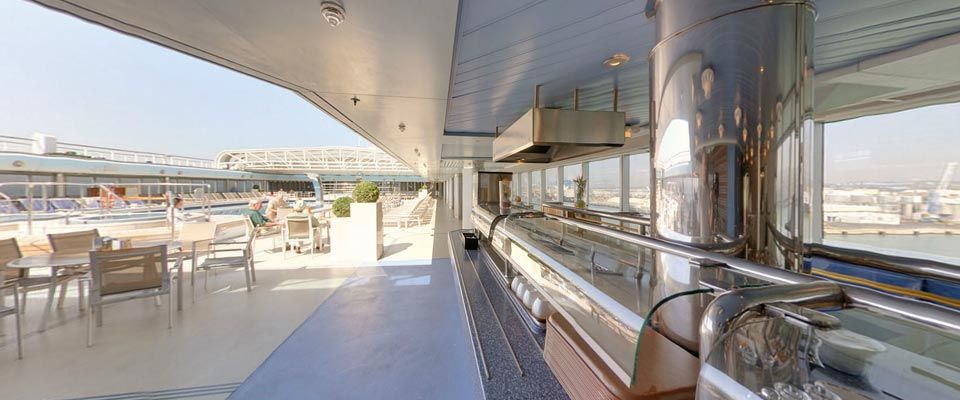
Enjoy a variety of snacks including burgers, hot dogs and fish and chips (this dining option is included in the price of your holiday).
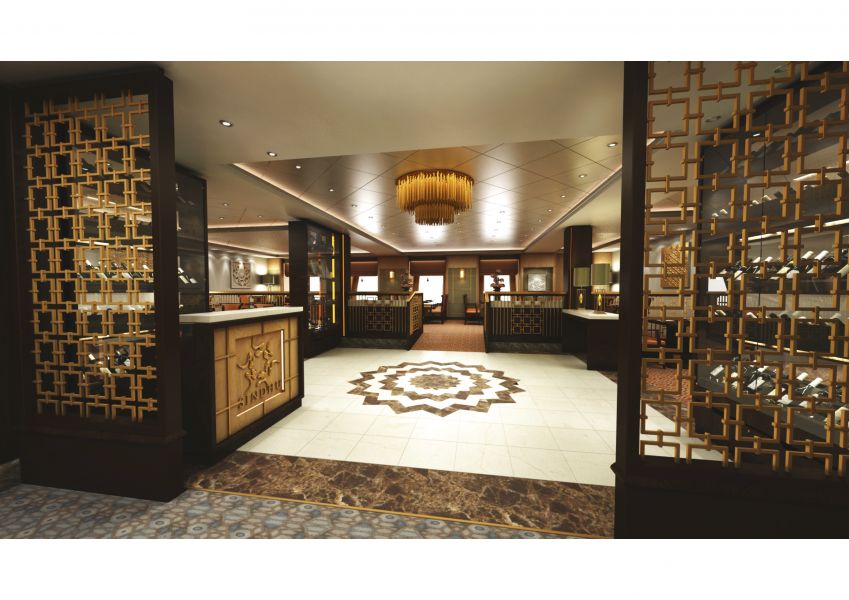
Showcasing a menu which is a triumph of perfectly balanced spices, delicate flavours and wonderful aromas, Sindhu has become a firm favourite with many. Dishes such as pan-roasted beef tenderloin and spiced mash vie for your attention, alongside ginger and mint tiger prawns and the signature dish – a trio of fragrant curries. So why not take a seat amidst the opulent decor and experience a treat for your senses?
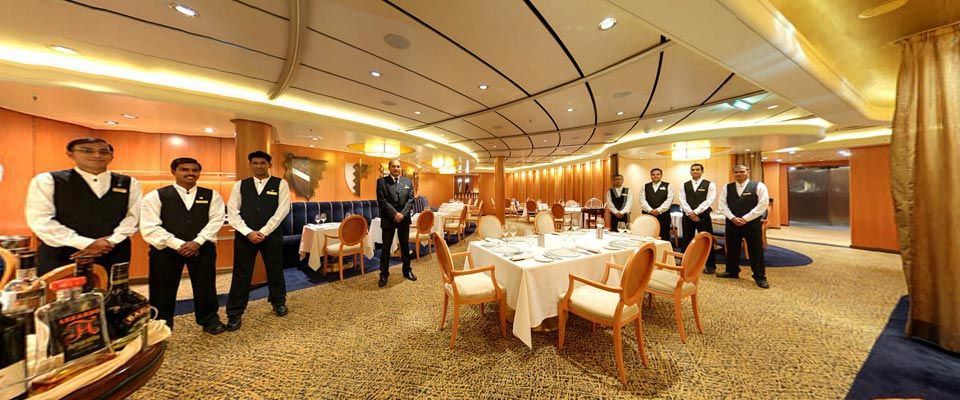
Ocean Grill by Marco Pierre White is the spot to savour mouth watering steaks and seafood. As you would expect from one of the world’s leading chefs, attention to detail is paramount and provenance and quality are key. The dishes, while simple, are masterfully presented, delivering exceptional flavours. And in the spirit of all great London grill restaurants, the ambience is relaxed yet sophisticated.
The images shown are for illustration purposes only and may not be an exact representation of what you find on the ship.
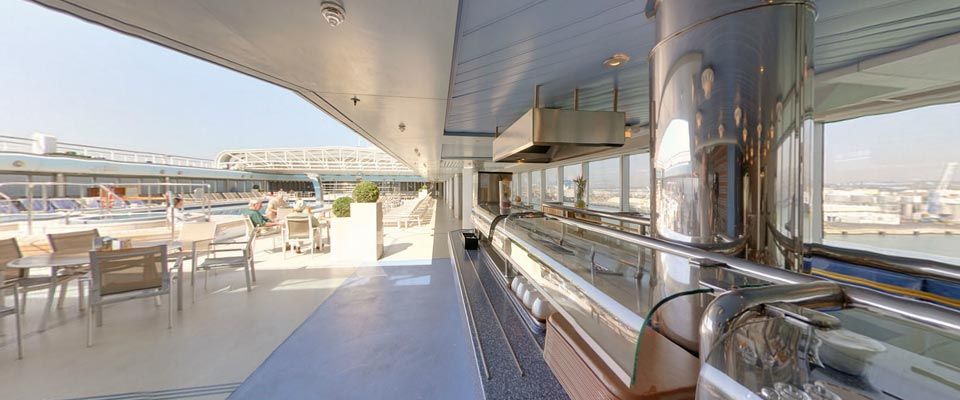
The Neptune's Bar is protected by the sliding glass Skydome, including the Neptune Pool and Neptune Grill, so you won't have to worry about it raining on your fun!
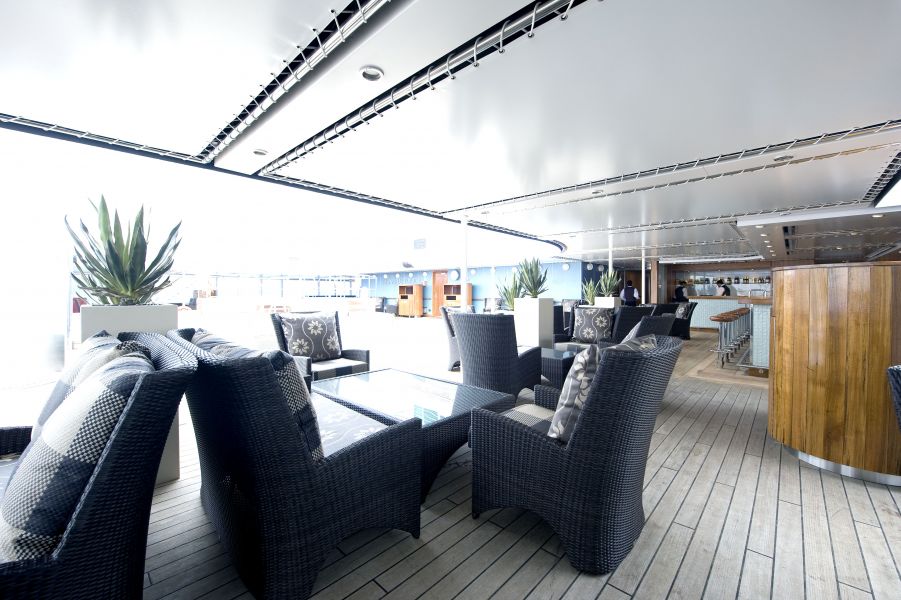
At the stern of Lido Deck, just forward of the Aquarius Pool is the Aquarius Bar. Enjoy a brief respite from the sun on one of its stools or stay on your deck lounger and have a refreshing cocktail - or two!
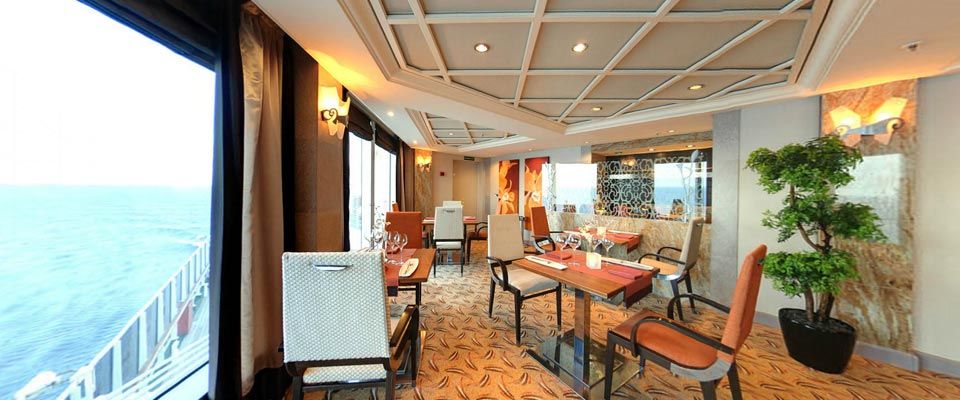
You will find East Bar at the highest point of the ship - Sky Deck. As you enter this colonial style bar you are welcomed by an array of drawings and paintings created by Martin Williams, which form a travelogue of journeys through Asia. As the sun sets and warm ambient light pours into the room, you can enjoy a pre-dinner drink before dining on the most wonderful Asian cuisine in the nearby Sindhu, or stop by later for a post-dinner drink.
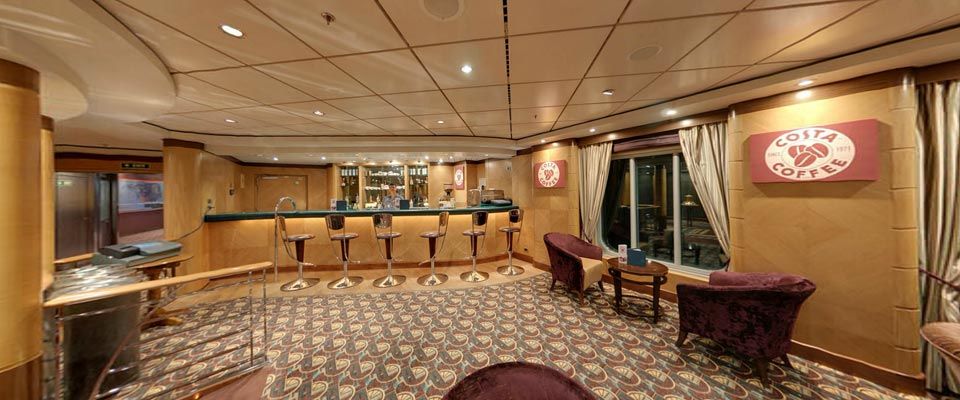
Nestled between Intermezzo and the Meridian Restaurant, is the yacht-inspired Spinnaker Bar. Its sophisticated yachting theme is evident in its contemporary décor, featuring wood, steel and chrome, it has porthole style mirrors and ship memorabilia. As it is just off the central walkway and close to the restaurants and evening entertainment, you will find that it is the perfect meeting place for a pre or post dinner tipple.
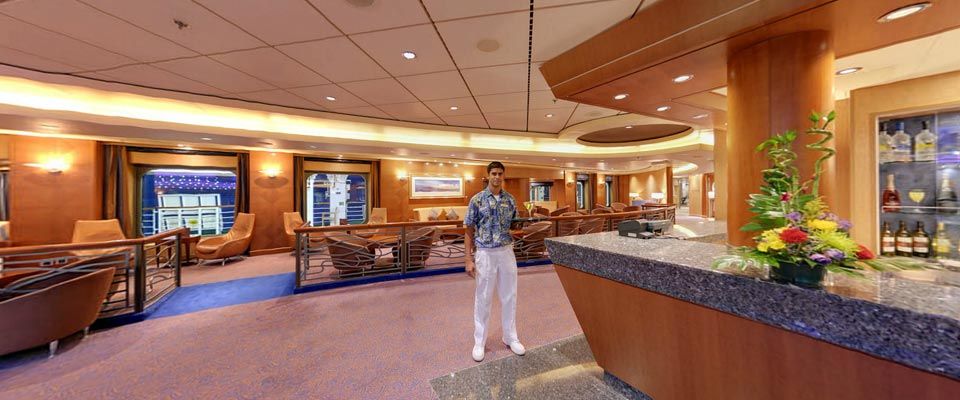
Situated at the very heart of the ship on Promenade Deck is the tastefully designed Piano Bar. Its position at the top of the atrium means it benefits from a close view of the intricate glass ceiling created by the artist Jo Downs. The light emanating from its rich hues of purples, pinks and blues combines with light wood walls and a low ceiling to give the Piano Bar an intimate evening feel. As the name suggests, in pride of place is the piano, where the resident pianist provides a backdrop to your conversation.
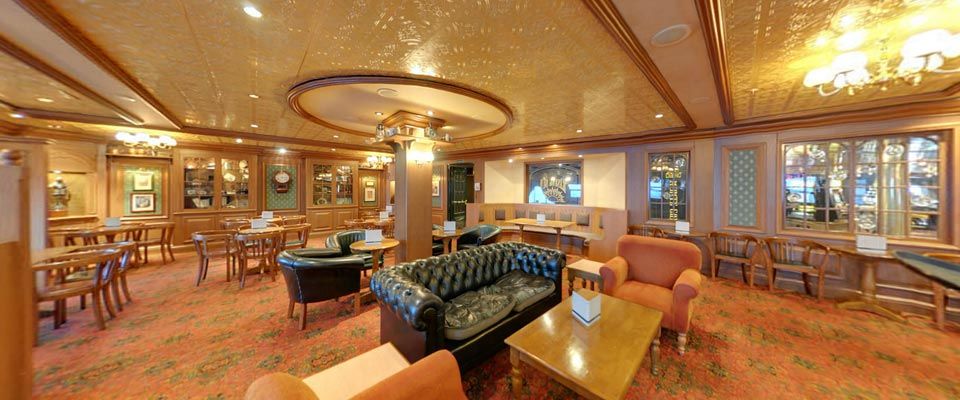
Walk into The Rising Sun and the only thing to remind you you’re not in a fine old country pub may be the ever-changing view from the window. As befits such a traditional establishment, there’s a jukebox and snug bar creating a buzzy pub atmosphere, with everything from darts, karaoke, live music, pub quizzes and major sporting event screenings to keep you entertained.
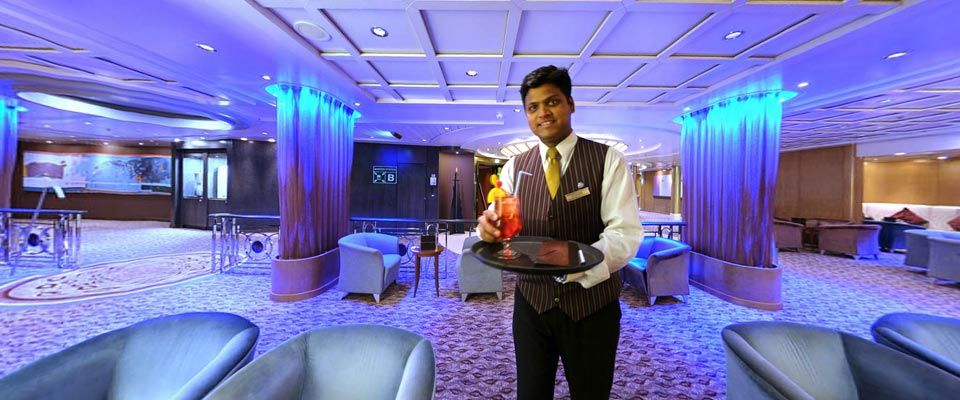
Make your evening that little bit more special with a visit to Intermezzo, an exclusive cocktail and Champagne bar located on F Deck. Luxuriate with a glass of Champagne or your favourite cocktail. Feature columns are dressed in rich sheer curtains, adding soft lighting by evening when the columns are lit from within. Classy, modern and the place to be seen, Intermezzo provides an elegant backdrop for an unforgettable evening.
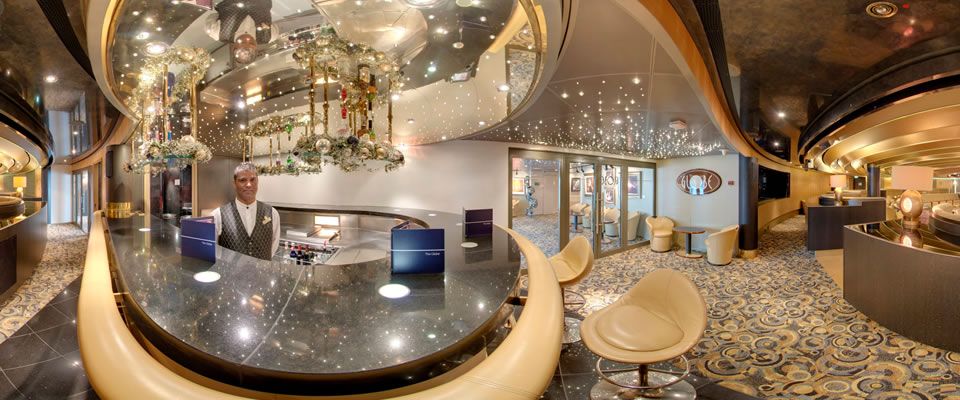
The Globe provides a wealth of entertainment. You enter this room from the starboard side corridor, and as you do so, you'll be met by a shining black marble bar with small starlights sparkling overhead. As the name suggests the room is circular and its subtle lighting brings a warm ambience to the room in the form of recessed lights and elegant lamps. Curvy seating and a black and gold colour scheme continue the room's classy atmosphere and fluid lines. Here you might catch the latest film release on its cinema screen, attend an art auction, enjoy a late night cabaret or boogie the night away to some live music.
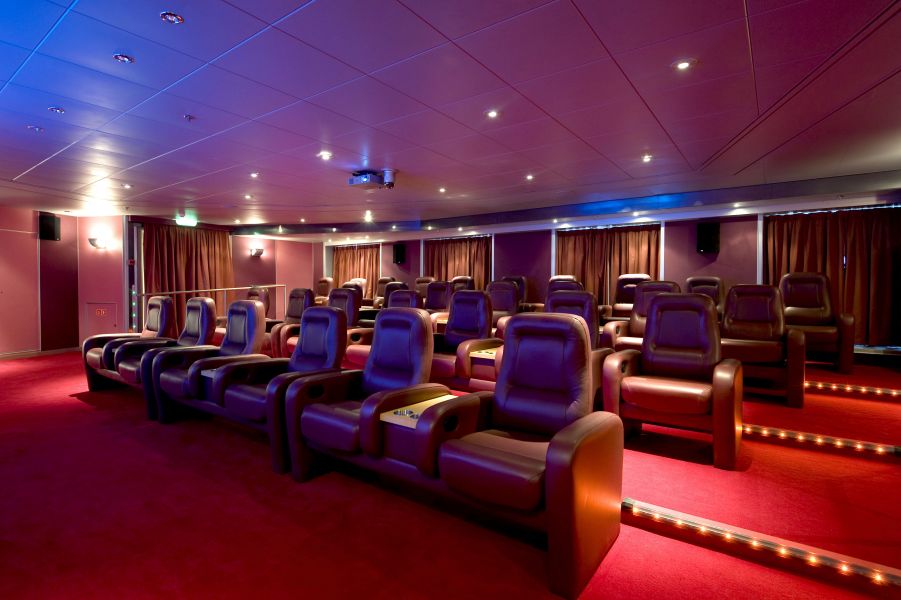
This 30-seat boutique cinema is Arcadia's dedicated space for showing films on board. You'll find the cinema positioned on the starboard side of Promenade Deck, aft of the forward lifts and adjacent to the Horizon Suite
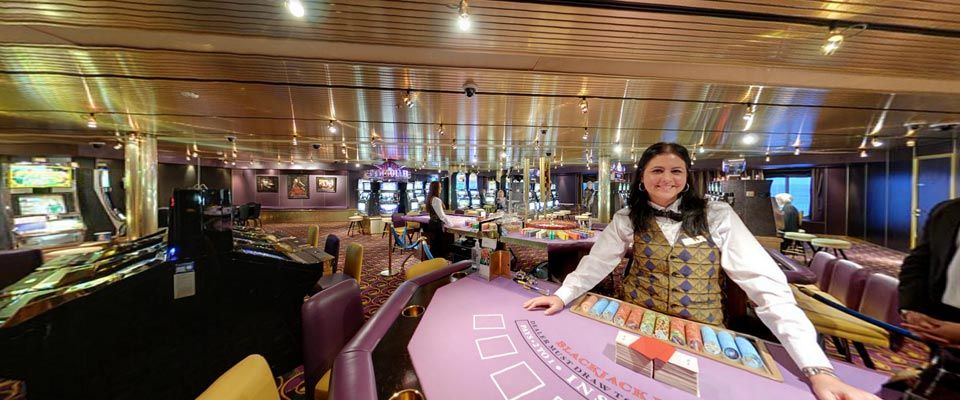
The Monte Carlo Casino is a great place to continue a fun night out after post dinner drinks or a show. The Monte Carlo Casino is conveniently located on F Deck forward next to the theatre and nightclub. It is adorned with rich fabrics including purple leather chairs around purple felt gaming tables and gives the casino a sumptuous, glamorous feel. In addition to the roulette table, two blackjack tables and three card poker table, you will find over 40 slot machines. The fun carpet complements the room well, reflecting the colour scheme of the yellows and purples of the furniture.
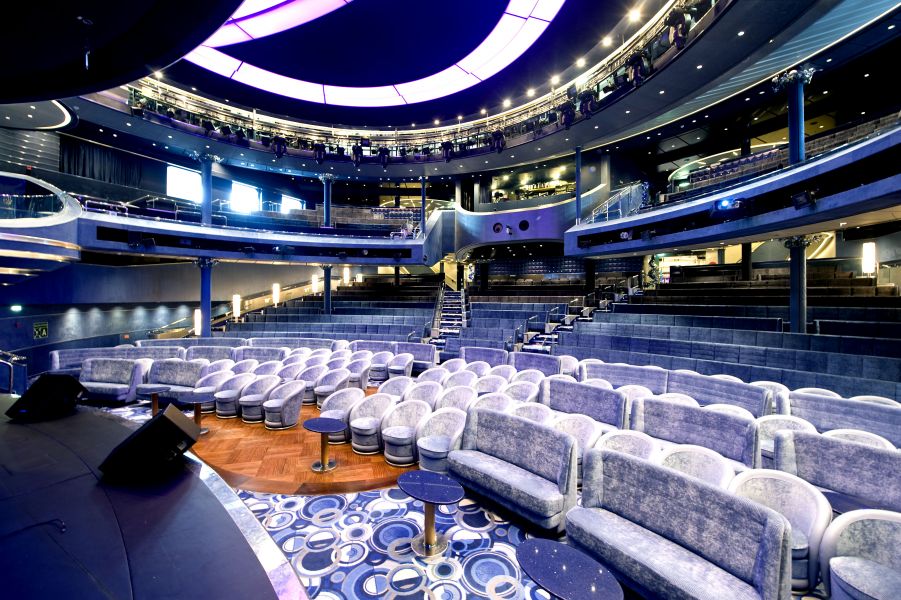
Arcadia's impressive three tier theatre, The Palladium, is located at the very forward end of the ship. Inside you will find comfortable theatre-style-seating arcs around the stage in three tiers, affording you excellent views of the stage. In The Palladium, the drama is not confined to the stage, as the décor adds a theatrical touch of its own. A rich colour scheme of royal blue, violet, midnight blue and silver sets off the main attraction - the shows themselves! Suede and crushed velvet adds an opulent touch, ensuring The Palladium has all the magic and anticipation of the West End!
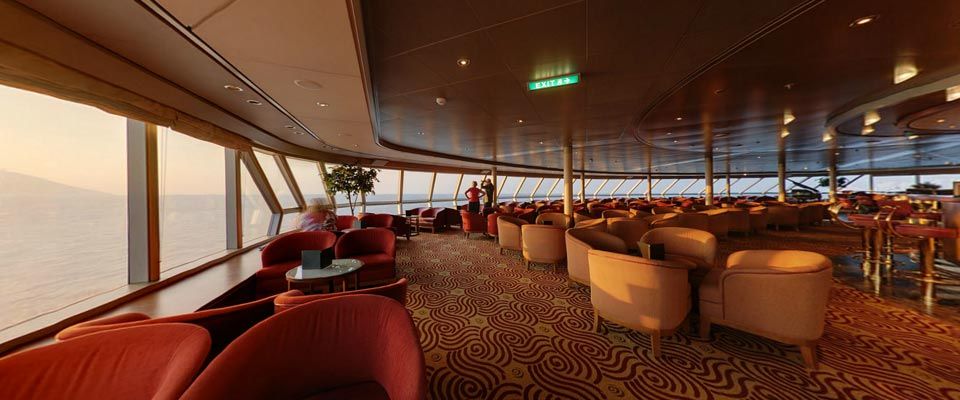
On Sun Deck forward is where you will find the appropriately named Crow's Nest. This relaxed lounge offers visitors sweeping panoramic ocean views and a convivial atmosphere. By day, you can sit back and relax with a book in one hand and a coffee in the other, pausing every now and again to enjoy the view. At night you'll be able to enjoy your favourite tipple to the sound of tinkling ivories. Jazz nights, cabaret and dancing all make the Crow's Nest a perfectly relaxed and elegant post-dinner venue.
The images shown are for illustration purposes only and may not be an exact representation of what you find on the ship.
The images shown are for illustration purposes only and may not be an exact representation of what you find on the ship.
| 16 nights aboard the Arcadia | |||
| Choose FREE on-board spend, coach transfers or car parking (Select Fares only) | |||
| Gratuities Included | |||
| Complimentary daily afternoon tea | |||
| Evening entertainment & Broadway style shows | |||
| Continental Breakfast in your cabin | |||
| 24-hour complimentary (standard) room service | |||
| Speciality Restaurants (charges may apply) | |||
| Port Taxes and Fees | |||
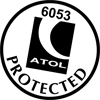 | ABTA and ATOL Protection* | ||
Date 5th Aug 2026 |
Nts 16 |
Interior £2,799pp |
Oceanview £2,699pp |
Balcony £3,299pp |
Suite  |
Date 5th Aug 2026 |
Nts 16 |
Interior £2,799pp |
Oceanview £2,699pp |
Balcony £3,299pp |
Suite  |

| Interior staterooms from | £2,799pp | ||
| SC | Single Inside |  | |
| OA | Larger Inside |  | |
| OB | Larger Inside |  | |
| OC | Larger Inside | £2,969pp | |
| PA | Inside |  | |
| PB | Inside |  | |
| PD | Inside | £2,869pp | |
| PE | Inside | £2,819pp | |
| PF | Inside | £2,799pp | |
| Oceanview staterooms from | £2,699pp | ||
| LB | Outside |  | |
| LC | Outside | £3,099pp | |
| LE | Outside |  | |
| LF | Outside |  | |
| NB | Outside (Obstructed View) | £2,769pp | |
| NC | Outside (Obstructed View) | £2,699pp | |
| Balcony staterooms from | £3,299pp | ||
| QF | Single Balcony |  | |
| EA | Deluxe Balcony |  | |
| EB | Deluxe Balcony | £3,549pp | |
| EC | Deluxe Balcony | £3,499pp | |
| ED | Deluxe Balcony | £3,449pp | |
| EE | Deluxe Balcony | £3,399pp | |
| EF | Deluxe Balcony | £3,299pp | |
| Suite staterooms |  | ||
| B1 | Suite |  | |
| B2 | Suite |  | |
| B4 | Suite |  | |
| CA | Mini-Suite |  | |
| CB | Mini-Suite |  | |
| CE | Mini-Suite |  | |
Early Saver Fare Benefits
P&O will assign your cabin ~ Second priority for dining ~ Second priority for upgrades ~ Low Deposit ~ Flexibility to change your booking. T&C’s apply.
| Interior staterooms from | £2,799pp | ||
| SC | Single Inside |  | |
| OA | Larger Inside |  | |
| OB | Larger Inside |  | |
| OC | Larger Inside | £2,969pp | |
| PA | Inside |  | |
| PB | Inside |  | |
| PD | Inside | £2,869pp | |
| PE | Inside | £2,819pp | |
| PF | Inside | £2,799pp | |
| Oceanview staterooms from | £2,699pp | ||
| LB | Outside |  | |
| LC | Outside | £3,099pp | |
| LE | Outside |  | |
| LF | Outside |  | |
| NB | Outside (Obstructed View) | £2,769pp | |
| NC | Outside (Obstructed View) | £2,699pp | |
| Balcony staterooms from | £3,299pp | ||
| QF | Single Balcony |  | |
| EA | Deluxe Balcony |  | |
| EB | Deluxe Balcony | £3,549pp | |
| EC | Deluxe Balcony | £3,499pp | |
| ED | Deluxe Balcony | £3,449pp | |
| EE | Deluxe Balcony | £3,399pp | |
| EF | Deluxe Balcony | £3,299pp | |
| Suite staterooms |  | ||
| B1 | Suite |  | |
| B2 | Suite |  | |
| B4 | Suite |  | |
| CA | Mini-Suite |  | |
| CB | Mini-Suite |  | |
| CE | Mini-Suite |  | |
Select Price Fare Benefits
Choice of cabin ~ First priority dining ~ First priority upgrades ~ Choice of on-board spending money*, car parking* or return coach travel* ~ Low Deposit ~ Flexibility to change your booking ~ Shuttle buses in port (where available). T&C’s apply
*Not available on cruises less than 5 nights
| Interior staterooms from | £2,999pp | ||
| SC | Single Inside |  | |
| OA | Larger Inside |  | |
| OB | Larger Inside |  | |
| OC | Larger Inside | £3,209pp | |
| PA | Inside |  | |
| PB | Inside |  | |
| PD | Inside | £3,099pp | |
| PE | Inside | £3,069pp | |
| PF | Inside | £2,999pp | |
| Oceanview staterooms from | £2,999pp | ||
| LB | Outside |  | |
| LC | Outside | £3,369pp | |
| LE | Outside |  | |
| LF | Outside |  | |
| NB | Outside (Obstructed View) | £3,059pp | |
| NC | Outside (Obstructed View) | £2,999pp | |
| Balcony staterooms from | £3,699pp | ||
| QF | Single Balcony |  | |
| EA | Deluxe Balcony |  | |
| EB | Deluxe Balcony | £3,949pp | |
| EC | Deluxe Balcony | £3,829pp | |
| ED | Deluxe Balcony | £3,799pp | |
| EE | Deluxe Balcony | £3,749pp | |
| EF | Deluxe Balcony | £3,699pp | |
| Suite staterooms |  | ||
| B1 | Suite |  | |
| B2 | Suite |  | |
| B4 | Suite |  | |
| CA | Mini-Suite |  | |
| CB | Mini-Suite |  | |
| CE | Mini-Suite |  | |
Fusion Cruises when selling travel arrangements is a trading name of The Midcounties Co-operative Ltd. Fusion Cruises is an Accredited Body Member of Midcounties Co-operative Travel Consortium. (ABTA:P6652, ATOL:6053).
Book with Confidence. We are a Member of ABTA which means you have the benefit of ABTA’s assistance and Code of Conduct.
Some of the flights and flight-inclusive holidays on this website are financially protected by the ATOL scheme but ATOL protection does not apply to all holiday and travel services offered on this website. This website will provide you with information on the protection that applies in the case of each holiday and travel service offered before you make your booking. If you do not receive an ATOL Certificate then the booking will not be ATOL protected. If you do receive an ATOL Certificate but all parts of your trip are not listed on it, those parts will not be ATOL protected. Please see our booking conditions for information, or for more information about financial protection and the ATOL Certificate go to: www.caa.co.uk
